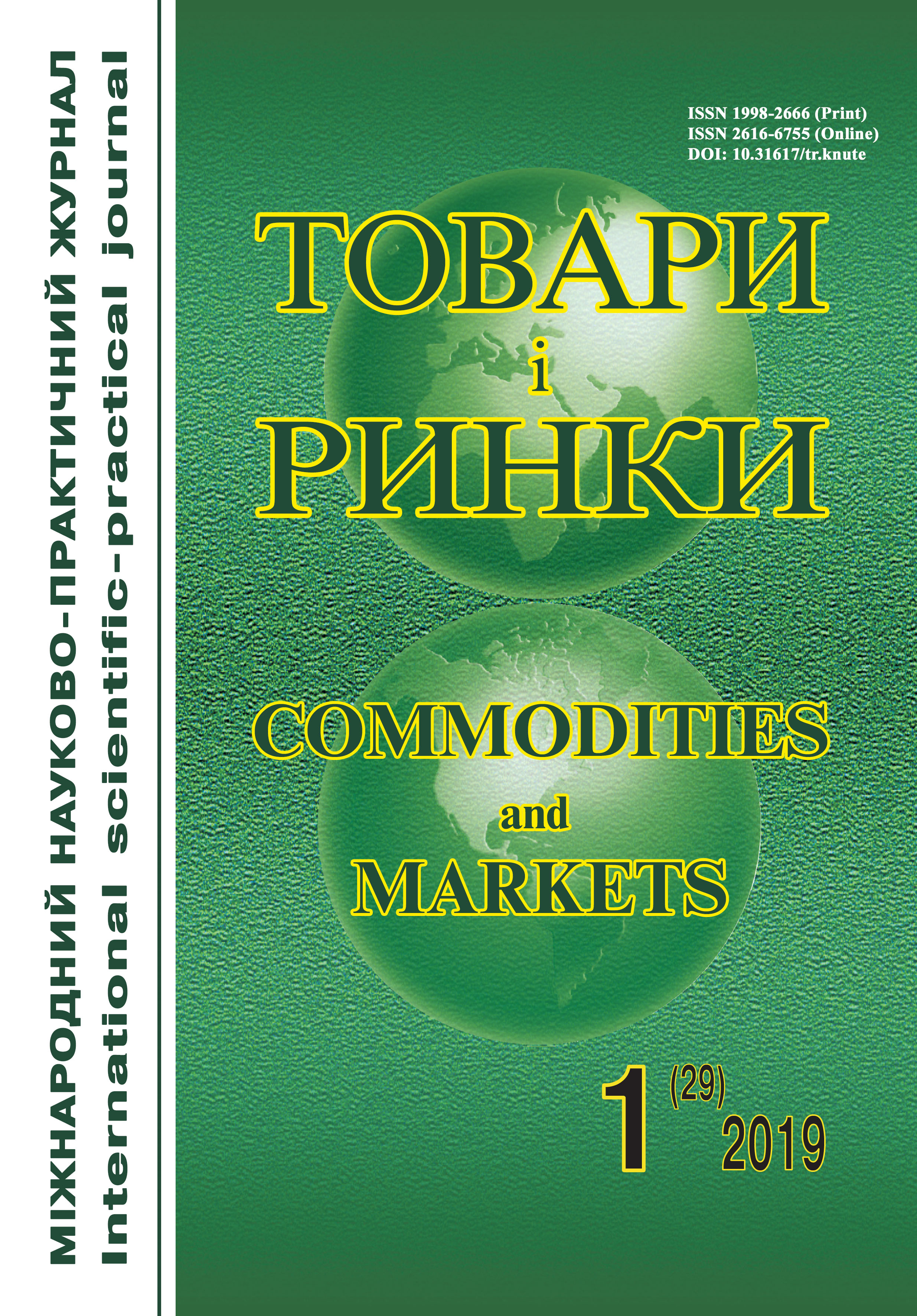Rheological properties of modified dispersions of montmorillonite
DOI:
https://doi.org/10.31617/tr.knute.2019(29)05Keywords:
rheological properties, modification, montmorillonite, aluminum compounds, viscosity, dermis structure.Abstract
Background. A special crystal lattice and a characteristic surface of clay mineralsmakes them widely used in various industries, including leather. As a result of modification, the mineral particles change the sign and the magnitude of charge of the surface, which makes it possible to form the structure of the dermis during the technological process of producing the skin of various intended purposes.
The aim of the work is to determine the rheological properties of dispersions of modified montmorillonite to produce tannery materials and to effectively form the structure of the dermis.
Materials and methods. Bentonite clays of Dashukivsky deposit (Cherkasy region, Ukraine) were used for the study. The content of montmorillonite in bentonite clays was 85 %. The modification was carried out in stages by sodium carbonate or alumina-potassium braids.
The study of rheological properties of modified dispersions included the determination of kinematic viscosity, pH, dynamic and plastic viscosity, velocity and shear stress.
Results. The results of studies of the influence of Al2O3 consumption for the modification of montmorillonite dispersions indicate that, with an increase in Al2O3 consumption up to 3.5 %, the displacement of the rheological curves into the zone of high shear stress occurs. These changes point to strengthening the structure and coagulation in the system. A further increase in the concentration of Al2O3 to the level of 7–20 % is characterized by a sharp decrease in the curves, and their displacement in the zone of lower values of shear stress, indicating the dilution of the dispersion and the complete peptization of the dispersion.
Conclusion. The ion exchange substitution of Na+-ions by the complex of aluminum ions substantially affects the rheological properties of mineral dispersions.
The obtaining of the most stable dispersions of montmorillonite occurs at the expense of aluminum compounds in terms of Al2O3 in the range of 5–7 %, which are characterized by a stable pH 3.0–3.5.
An increase in the concentration of aluminum compounds leads to significant dilution of dispersions and to a sharp drop in the viscosity of modified dispersions.
The positively charged modified dispersions of montmorillonite MMTAl can be used for further studies.
References
Alain, Meunier. (2007). Soil hydroxy-interlayered Minerals: A reinterpretation of their crystallo chemical properties. Clays and Clay Minerals. (Vol. 55), 4, 380-388 [in English].
Tarasevich, Ju. I. (1988). Stroenie i himija poverhnosti sloistyh silikatov [Structure and Surface Chemistry of Laminar Silicates]. Kyi'v: Naukova dumka [in Russian].
Chulkov, A. N., Dejneka, V. I., & Dejneka, L. A. (2011). Osobennosti ocenki ionoobmennyh harakteristik glin [Features of the assessment of clay ion exchange characteristics. Nauchnye vedomosti BelGU – Scientific statements of BelSU, 15 (110), issue 16, 88–94 [in Russian].
Mokrousova, O. R., & Moraru, V. N. (2010). Mineral'ni napovnjuvachi dlja shkir. Reologichni vlastyvosti ta dyspersnist' i'h vodnyh suspenzij [Mineral fillers for the skin. Rheological properties and dispersion of its aqueous suspensions]. Visnyk KNUTD – KNUTD Bulletin, 4, 256-264 [in Ukrainian].
Danylkovych, A. G., Gryshhenko, I. M., Lishhuk, V. I., Plavan, V. P., Kas'jan, E. Je. et al. (2012). Innovacijni tehnologii' vyrobnyctva shkirjanyh i hutrovyh materialiv ta vyrobiv [Innovative technologies of production of leather and fur materials and products]. A. G. Danylkovych (Ed.). Kyi'v: Feniks [in Ukrainian].
Pokid'ko, B. V., Pletnev, M. Ju., & Mel'nikova, M. M. (2011). Vlijanie jelektrolita na process strukturoobrazovanija v vodnyh dispersijah Na+ montmorillonita Taganskogo mestorozhdenija [Influence of electrolyte on the process of structuring in the aqueous dispersions of Na+ montmorillonite of Taganskoye field]. Vestnik MITHT – Herald of MSUFCT. (Vol. 6), 6, 113-119 [in Russian].
Hil'ko, S. L., Titov, E. V., & Tretinnik, V. Ju. (2008). Vlijanie sil'nyh jelektrolitov na reologicheskie svojstva vodnyh suspenzij Na-bentonita [Effect of strong electrolytes on the rheological properties of aqueous suspensions of Na-bentonite]. Nanosystemy, nanomaterialy, nanotehnologii' – Nanosystems, nanomaterials, nanotechnologies. (Vol. 6), issue 2, 557-562 [in Ukrainian].
Kadoshnikov, V. M., Zabulonov, Ju. L., Litvinenko, Ju. V., Makarov, A. S., & Savickij, D. P. (2010). Svojstva vodnyh suspenzij glinistyh mineralov, aktivirovannyh peremennym jelektromagnitnym polem [Properties of aqueous suspensions of clay minerals activated by alternating electromagnetic field]. Mineralogichnyj zhurnal – Mineralogy journal. (Vol. 32), 4, 41-50 [in Ukrainian].
Abu-Jdayil, B., Ghannam, M., & Nasser, M. S. (2016). The Modification of Rheological Properties of Bentonite-Water Dispersions with Cationic and Anionic Surfactants. International Journal of Chemical Engineering and Applications. (Vol. 7), 2, 74-80. DOI: https://doi.org/10.7763/IJCEA.2016.V7.546 [in English].
Golovteeva, A. A., Kucidi, D. A., & Sankin, L. B. (1987). Laboratornyj praktikum po himii i tehnologii kozhi i meha [Laboratory Workshop on Chemistry and Technology of Leather and Fur] (3-d ed., rev.). M.: Legprombytizdat [in Russian].



